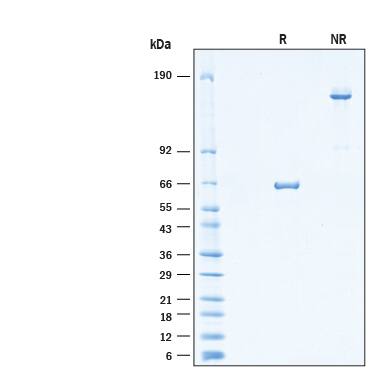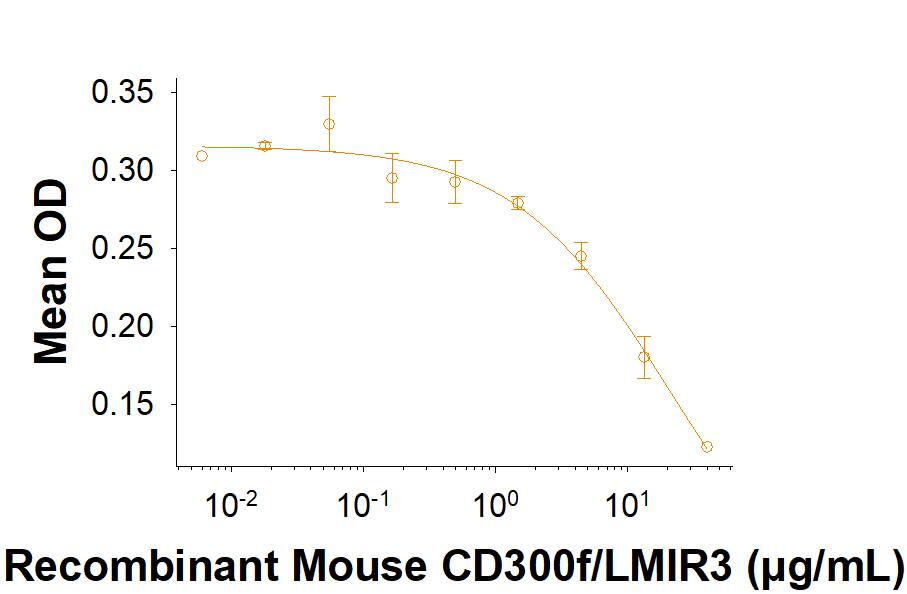Recombinant Mouse CD300f/LMIR3 Fc Chimera Protein, CF
R&D Systems, part of Bio-Techne | Catalog # 10967-LM

Key Product Details
Source
NS0
Accession #
Structure / Form
Disulfide-linked homodimer
Conjugate
Unconjugated
Applications
Bioactivity
Product Specifications
Source
Mouse myeloma cell line, NS0-derived mouse CD300f/LMIR3 protein
| CD300f/LMIR-3 (Cys16-Gly188) Accession # Q6SJQ7.1 |
IEGRMDP | Mouse IgG2a (Glu98-Lys330) |
| N-terminus | C-terminus |
Purity
>95%, by SDS-PAGE visualized with Silver Staining and quantitative densitometry by Coomassie® Blue Staining.
Endotoxin Level
<0.10 EU per 1 μg of the protein by the LAL method.
N-terminal Sequence Analysis
Cys16 & Glu20
Predicted Molecular Mass
46 kDa
SDS-PAGE
55-65 kDa, under reducing conditions.
Activity
Measured by its ability to inhibit anti-CD3 antibody induced IL-2 or IFN-gamma secretion by human T cells. The ED50 for this effect 1.50-15.0 μg/mL.
Scientific Data Images for Recombinant Mouse CD300f/LMIR3 Fc Chimera Protein, CF
Recombinant Mouse CD300f/LMIR3 Fc Chimera Protein Bioactivity.
Measured by its ability to inhibit anti-CD3 antibody induced IL-2 secretion by human T cells. The ED50 for this effect 1.50 - 15.0 μg/mL.Recombinant Mouse CD300f/LMIR3 Fc Chimera Protein SDS-PAGE.
2 μg/lane of Recombinant Mouse CD300f/LMIR3 Fc Chimera Protein (Catalog # 10967-LM) was resolved with SDS-PAGE under reducing (R) and non-reducing (NR) conditions and visualized by Coomassie® Blue staining, showing bands at 55-65 kDa and 110-130 kDa, respectively.Formulation, Preparation and Storage
10967-LM
| Formulation | Lyophilized from a 0.2 μm filtered solution in PBS. |
| Reconstitution | Reconstitute at 500 μg/mL in PBS. |
| Shipping | The product is shipped at ambient temperature. Upon receipt, store it immediately at the temperature recommended below. |
| Stability & Storage | Use a manual defrost freezer and avoid repeated freeze-thaw cycles.
|
Background: CD300f/LMIR3
References
- Clark, G.J. et al. (2009) Trends Immunol. 30:209.
- Izawa, K. et al. (2012) Immunity 37:827.
- Alvarez-Errico, D. et al. (2004) Eur. J. Immunol. 34:3690.
- Korver, W. et al. (2009) Leukemia 23:1587.
- Izawa, K. et al. (2009) J. Immunol. 183:925.
- Alvarez-Errico, D. et al. (2007) J. Immunol. 178:808.
- Can, I. et al. (2008) J. Immunol. 180:207.
- Izawa, K. et al. (2007) J. Biol. Chem. 282:17997.
- Shi, L. et al. (2006) Blood 108:2678.
- Xi, H. et al. (2010) J. Exp. Med. 207:7.
Long Name
Leukocyte Mono Ig-like Receptor 3
Alternate Names
CD300f, CD300LF, CLIM1, CLM1, DIgR2, IGSF13, IREM-1, LMIR3, NKIR, Pigr3
Gene Symbol
CD300LF
UniProt
Additional CD300f/LMIR3 Products
Product Documents for Recombinant Mouse CD300f/LMIR3 Fc Chimera Protein, CF
Product Specific Notices for Recombinant Mouse CD300f/LMIR3 Fc Chimera Protein, CF
For research use only
